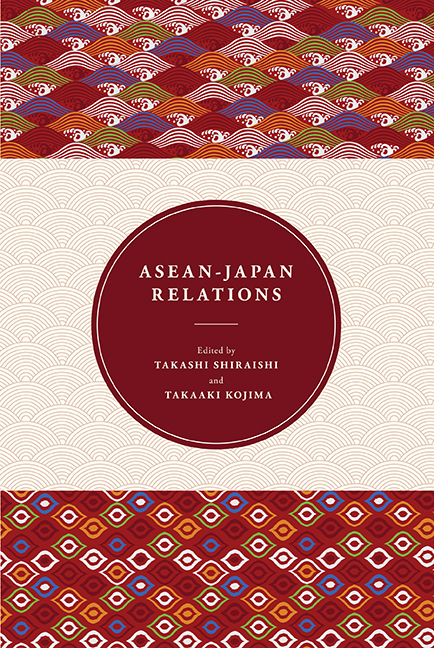Book contents
- Frontmatter
- Contents
- Preface
- About the Contributors
- 1 An Overview of Japan-ASEAN Relations
- 2 Japan's Relations with ASEAN
- 3 Approaches toward Regionalism: Japan, China and the Implications on ASEAN
- 4 The New Japan-ASEAN Partnership: Challenges in the Transformation of the Regional Context in East Asia
- 5 ASEAN-Japan Strategic Partnership and Regional Integration: Impacts and Implications
- 6 ASEAN-Japan Cooperation on Maritime Non-Traditional Security Issues: Toward a New Paradigm
- 7 Japan's Evolving Security Concerns in Maritime Southeast Asia: From Safety of Navigation to “Lake Beijing”
- 8 Evolution of Institutions and Policies for Economic Integration in East Asia: The Rise of China and Changes in the Regional Order
- 9 Managing Integration in East Asia: Behind Border Issues in Japan-ASEAN Trade Agreements
- 10 Regional Financial Cooperation in East Asia: Development and Challenges
- 11 Japanese Development Assistance to ASEAN Countries
- 12 Japanese Foreign Direct Investment in the ASEAN-4 Countries
- 13 Japan's Triple Tsunami
- 14 ASEAN-Japan Relations: A Singapore Perspective
14 - ASEAN-Japan Relations: A Singapore Perspective
Published online by Cambridge University Press: 21 October 2015
- Frontmatter
- Contents
- Preface
- About the Contributors
- 1 An Overview of Japan-ASEAN Relations
- 2 Japan's Relations with ASEAN
- 3 Approaches toward Regionalism: Japan, China and the Implications on ASEAN
- 4 The New Japan-ASEAN Partnership: Challenges in the Transformation of the Regional Context in East Asia
- 5 ASEAN-Japan Strategic Partnership and Regional Integration: Impacts and Implications
- 6 ASEAN-Japan Cooperation on Maritime Non-Traditional Security Issues: Toward a New Paradigm
- 7 Japan's Evolving Security Concerns in Maritime Southeast Asia: From Safety of Navigation to “Lake Beijing”
- 8 Evolution of Institutions and Policies for Economic Integration in East Asia: The Rise of China and Changes in the Regional Order
- 9 Managing Integration in East Asia: Behind Border Issues in Japan-ASEAN Trade Agreements
- 10 Regional Financial Cooperation in East Asia: Development and Challenges
- 11 Japanese Development Assistance to ASEAN Countries
- 12 Japanese Foreign Direct Investment in the ASEAN-4 Countries
- 13 Japan's Triple Tsunami
- 14 ASEAN-Japan Relations: A Singapore Perspective
Summary
INTRODUCTION
ASEAN and Japan are partners. For a partnership to succeed, it must be grounded on shared interests, common objectives, and mutual trust and confidence. A partnership will not succeed if the partners do not have shared interests or common objectives or if they do not trust each other. In 1977, Prime Minister Takeo Fukuda pledged that Japan would do its best to establish an equal partnership of mutual confidence and trust based on “heart-to-heart” understanding between ASEAN and Japan.
Shared Interests
I will begin this essay by asking whether ASEAN and Japan have shared interests. I will argue that they do. What are their shared interests? They have a shared interest in maintaining peace and stability in East Asia and Asia-Pacific. They have a shared interest in promoting sustainable development and human security. They have a shared interest in promoting regional cooperation and integration.
Common Objectives
ASEAN and Japan have many common objectives. Let me list some of them. They aim to increase trade and investment between them. They aim to facilitate the manufacturing, trading, and servicing activities of the private sector in the two economies. They aim to increase the flow of tourists, students, interns, and talented workers between the two sides. They aim to enhance financial cooperation between them. They aim to augment the connectivity among the ten ASEAN countries and between ASEAN and Japan. They aim to promote human security in ASEAN, through the efficient, productive, and wise use of Japan's official development assistance (ODA). They aim to maintain the freedom of navigation and the security of strategic sea-lanes, such as the Straits of Malacca and Singapore, as well as the Lombok and Sunda Straits. They aim to promote a balance of power in Asia-Pacific and to reduce tension, suspicion, and misunderstanding. They aim to promote greater regional cooperation and integration, bilaterally, as well as through the various regional and sub-regional institutions. They will continue to support the central role that ASEAN plays in those institutions and processes. They also aim to cooperate to promote the green economy and to abide by the ancient Asian ethic that Man must live in harmony with Nature.
- Type
- Chapter
- Information
- ASEAN-Japan Relations , pp. 284 - 294Publisher: ISEAS–Yusof Ishak InstitutePrint publication year: 2013



